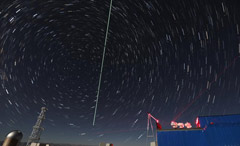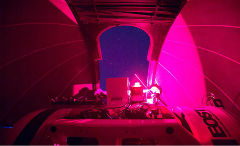China's quantum communication satellite achieves scientific goals
2017-08-11
cgtn.com
China’s quantum communications satellite, also the first one in the world, has successfully achieved three preset scientific goals ahead of time since its launch in August 2016, announced Chinese Academy of Sciences at a news conference.
With a mission named “Quantum Experiments at Space Scale” (QUESS), the satellite blasted off from the Jiuquan Satellite Launch Center in the Gobi Desert aboard a Long March 2D rocket.
The satellite is called “Mozi” in Chinese, or “Micius,” after the ancient Chinese philosopher and scientist, credited as the first person to conduct optical experiments.
The mission, initially planned to operate for two years, is completed within only one year, said Pan Jianwei, who led the research team and is an academician with the Chinese Academy of Sciences pioneering in quantum space. The results were published on the journal Nature on Aug 10.
What is quantum in simple language?
Quantum satellite is designed to establish “hack-proof” communications between parties by transmitting un-crackable keys from space to ground stations.
The first goal was accomplished in June this year when Micius sent photons, the basic quantum particles that make up light, to two ground stations that were separated by 1,200 kilometers, beating the previous record of 144 kilometers. The result was published on the journal Science.
This pioneering experiment intends to test if the spooky property of quantum entanglement can operate at long distances by sending entangled pair of photons between receivers in Delingha and Lijiang, which, if succeeded, could have huge implications for cryptography.
Following its first experiment, Micius also achieved a task in quantum key distribution, the exchange of cryptographic keys between two parties also via entangled photons, sent by the orbiting satellite.
The operators of the system, upon receiving the photons, would then measure them and decide an encryption key, which makes the communication between them inherently secure, because any attempt to eavesdrop would cause the quantum state of the photons to collapse.
The third task of QUESS is quantum teleportation, which is meant to test the fundamental laws of quantum mechanics at a space scale. This involves using entangled photons alongside information transmitted by more conventional means to reconstruct the quantum state in a new location.
Specifically, researchers created a pair of entangled photons, one of which was left on the ground while the other being sent to the satellite. A third photon will also be prepared to engage in new entanglement with the one on the ground.
According to quantum theory, when two photons become entangled, or a pair, on the ground, the one in space will no longer be entangled to the one on the ground, and will display properties of the second photon on the ground. This means that photon is being “transported” to space.
China plans to use its quantum satellite system to cover the planet by 2030.



